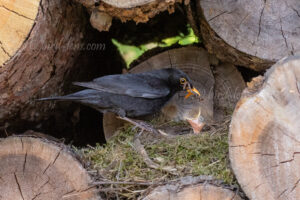 The melodic song of the male Eurasian Blackbird (Turdus merula) could already be heard in late winter. On a recently set up wooden pile in the backyard there was suddenly a finely woven nest – quite open at a height of approx. 1.80 m. So a pair of Eurasian Blackbirds had set up their nest right at a workplace. 4 green eggs with black patterns lay in the nest at end of April. After days of brooding and waiting, the Eurasian Blackbird chicks could be seen laying down in the nest. They stayed very quiet, no chirping of hungry Blackbird chicks could be heard.
The melodic song of the male Eurasian Blackbird (Turdus merula) could already be heard in late winter. On a recently set up wooden pile in the backyard there was suddenly a finely woven nest – quite open at a height of approx. 1.80 m. So a pair of Eurasian Blackbirds had set up their nest right at a workplace. 4 green eggs with black patterns lay in the nest at end of April. After days of brooding and waiting, the Eurasian Blackbird chicks could be seen laying down in the nest. They stayed very quiet, no chirping of hungry Blackbird chicks could be heard.
Nevertheless, from time to time you could see the tip of a yellowish beak sticking out of the nest. That would be something for a remotely triggered recording – would´nt it be? A good opportunity to position the Canon EOS 1DX Mark III at a Sigma 2,8/ 180 – 300 on a Gitzo tripod. Now I wanted to sit in the sun at a distance (no more than 8 meters; the built-in WiFi doesn’t do more) and just look at the laptop from time to time and then trigger it remotely if I like it and see action. Once the camera and laptop had recognized each other via EOS Utility on the one hand and the right setting of the “communication function” (tab in the camera control), we could get start.
This worked excellently. The delay in displaying what is happening on the screen or setting/changing the autofocus point naturally takes a while, of course. At first I worked with single-point AF. It’s very nice that you can also re-adjust “manually” remotely. There are even 3 different modes from very fine to rather coarse focusing settings. To do this, you should switch to 5x magnification to get the last bit of sharpness out of your subject. Basically impossible with moving subjects. But the blackbird always cared for the young in the nest in the same place. I first used single AF at 1/500 sec. But it’s always amazing how shallow the depth of field is. By setting a minimum aperture of 4.0 in the menu of the EOS 1 DX Mark III, I tried to get a little more leeway in the focusing. However, the success is not resounding and the ASA numbers are of an order of magnitude that is no longer necessarily beneficial to the image result. Every now and then I was able to photograph the sitting Blackbird (the female) at 1/125 sec. You shouldn’t have high expectations about the lifespan of the battery. After about 4 hours the battery runs out. In the LiveView setting, battery consumption is not insignificant. The Canon EOS 1DX III creates 20 frames per second in live images with the electronic shutter. This is absolutely impressive. This is where CFExpress memory cards really come into their own. Essentially you can shoot endlessly in RAW format at 20fps; the buffer is free again very quickly. I haven’t reached any capacity limits yet. LiveView turns the camera into a mirrorless EOS-1, yes it is a fully-fledged mirrorless camera in LiveView. The AF speed and the small – although noticeable – delay in reproducing the event, even in remote control mode, make the photography process extremely pleasant and professional.
It can be assumed that the parents’ search for food began every morning. Protein-rich food is perfect for the growth and development of young Eurasian Blackbirds.
Sometimes it only takes a short time for the female or male to return to the nest. But sometimes the hunt seems more difficult. The male in particular was consistently able to find a large number of caterpillars and bring them to the nest. Loaded with the nestling food in his beak, he came back to the nest where the hungry chicks were already waiting with their beaks open.
You could watch as the little fluffy balls grew stronger and larger with each portion of food. 2 days after the last recordings the nest was orphaned. Were the young already so fledged that they had left the nest? Or had a Eurasian Jay (Garrulus glandarius) taken over the open nest? The nest appeared intact. Questions upon questions!
In order to meet the growing demand for top images of the rarer species of Palaearctic Bird-lens.com has specifically made trips to remote places. Additionally every chance is used, if a rare bird is around the homeground. This to do everything to ensure excellent photos of the Birds of the Western Palearctic . The yield of pictures also of rare Western Palaearctic birds is very good. There are other nice images of birds, that you will find behind the tab “Picture Shop“. Just give a notice if you need a picture of a bird which is not online.